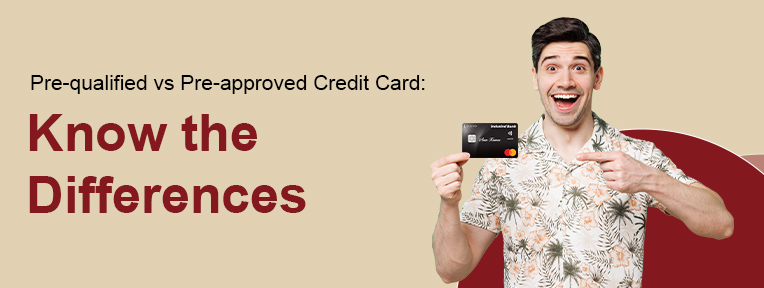
Pre-Qualified vs Pre-Approved Credit Card: Key Differences
Posted on Thursday, July 3rd, 2025 | By IndusInd Bank
Ever received a credit card offer that says you’re pre-qualified or pre-approved? At first glance, they might seem like the same thing—but there’s a subtle difference that could influence your next financial move. Knowing how pre-qualified vs pre-approved credit cards differ can help you understand your chances of approval, avoid unnecessary credit checks, and boost your financial confidence. Let’s break it all down.
What Does Credit Card Pre-approval Mean?
A credit card pre-approval means the card issuer has done a soft pull of your credit report and determined you meet certain criteria for a credit card offer. This is usually based on information from credit bureaus or your past history with the bank.
Think of it as being shortlisted before an interview—you’re not guaranteed the job (or card), but you’re ahead of many others.
Unlike a formal application, this doesn’t affect your credit score. However, if you accept the offer and submit a full application, a hard inquiry will follow.
Facts about Credit Card Pre-approvals
- Soft Credit Check Only: No impact on your credit score unless you apply.
- Targeted Offers: Often based on your credit behavior and profile.
- Time-Sensitive: Pre-approval offers can expire, so don’t sit on them too long.
- Higher Approval Odds: You’re more likely to get approved if you apply after Pre-approval.
Benefits of Credit Card Pre-approvals
- Confidence Boost: Knowing you meet initial requirements helps reduce uncertainty.
- No Surprises: You’ve already passed the first level of credit evaluation.
- Tailored Offers: You’re shown cards you have a real shot at getting.
- Easy Comparison: Preapproved offers often come with clear details—interest rates, rewards, and limits.
What Does Pre-qualify Credit Cards Mean?
To Pre-qualify for a credit card, you typically provide some basic information—like your income, employment status, and possibly your PAN—and the issuer performs a soft credit check to assess eligibility.
This is often initiated by you, unlike Pre-approvals which are sent to you. It’s a way to see if you’re eligible before applying—without the pressure or a hit to your credit score.
Facts about Pre-qualify Credit Cards
- Consumer-Initiated: You check if you Pre-qualify—not the bank.
- No Obligation: Just because you Pre-qualify doesn’t mean you have to apply.
- Quick Results: Many online portals give instant eligibility checks.
- Not a Guarantee: Like Pre-approvals, this is not a final approval—just a good sign.
Benefits of Pre-qualify Credit Cards
- Explore Your Options: Pre-qualify across multiple issuers without hurting your credit.
- No Pressure: You’re testing the waters before diving in.
- Credit-Safe: Just a soft pull—so your credit score stays intact.
- Better Planning: Helps you shortlist cards that align with your creditworthiness.
What is Better: Credit Card Pre-approval or Pre-qualify Credit Cards?
Here’s the million-rupee question: which one is better?
The answer? It depends on your situation.
If you receive a credit card Pre-approval, it usually means the bank already has your details and has identified you as a promising candidate. This gives you stronger odds of getting the card.
If you Pre-qualify, you’re taking the first step yourself—more useful if you’re shopping around or unsure about your eligibility.
| Feature | Preapproved | Prequalified |
| Initiated By | Issuer (Bank) | Consumer (You) |
| Credit Check Type | Soft Pull | Soft Pull |
| Impact on Score | None (until you apply) | None (until you apply) |
| Approval Guarantee | Not guaranteed, but strong chances | Not guaranteed |
Bottom line? Pre-approvals might give you higher chances, but prequalification is a safer and flexible starting point if you’re testing options.
Tips for Getting Pre-qualify Credit Cards and Credit Card Pre-approvals
Want to boost your chances for either? Here’s what works:
- Maintain a Good Credit Score: Both processes still peek at your credit behavior.
- Pay Bills on Time: Timely repayments signal you’re financially reliable.
- Lower Your Credit Utilization: Keep card balances under 30% of the limit.
- Limit Hard Inquiries: Too many recent applications can turn off issuers.
- Provide Accurate Information: Whether you’re Pre-qualifying or getting preapproved, truthful data helps.
- Opt-In for Offers: Make sure your contact details are updated and you’re not opted out of promotional communications.
Conclusion
Navigating the world of credit cards gets easier when you understand the difference between pre-qualified vs pre-approved credit card offers. Both give you a preview of eligibility without impacting your credit score, but they cater to slightly different needs.
If you’re ready and confident, go with Pre-approval. If you’re testing the waters or comparing, start with prequalification. Either way, you’re taking a smart step towards better credit choices—minus the guesswork.



 Offers
Offers Rates
Rates Debit Card Related
Debit Card Related Credit Card Related
Credit Card Related Manage Mandate(s)
Manage Mandate(s) Get Mini Statement
Get Mini Statement
 categories
categories Bloggers
Bloggers Blog collection
Blog collection Press Release
Press Release


